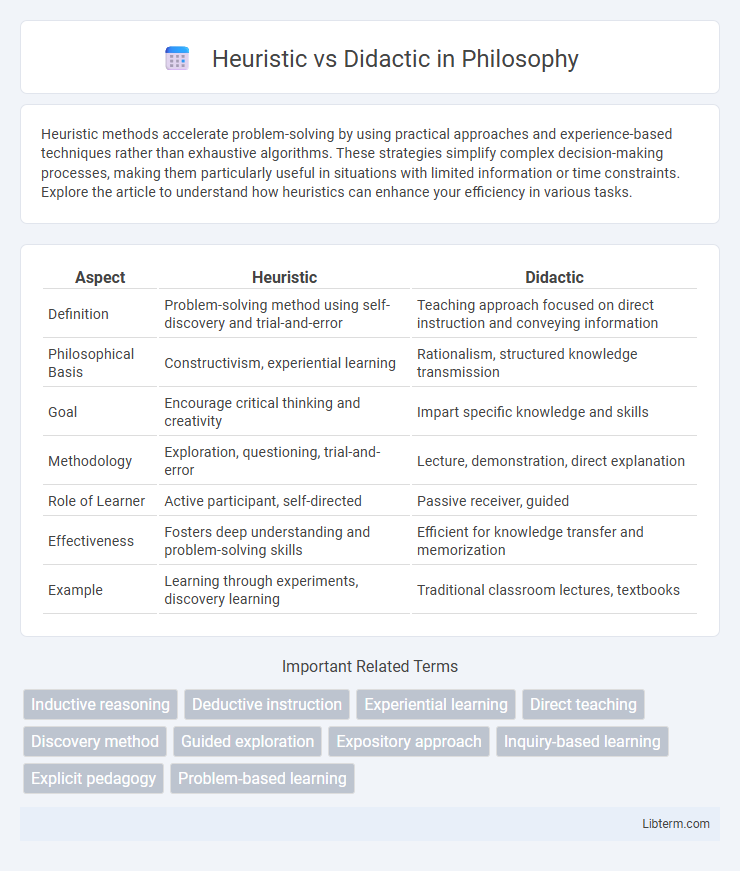Heuristic methods accelerate problem-solving by using practical approaches and experience-based techniques rather than exhaustive algorithms. These strategies simplify complex decision-making processes, making them particularly useful in situations with limited information or time constraints. Explore the article to understand how heuristics can enhance your efficiency in various tasks.
Table of Comparison
| Aspect | Heuristic | Didactic |
|---|---|---|
| Definition | Problem-solving method using self-discovery and trial-and-error | Teaching approach focused on direct instruction and conveying information |
| Philosophical Basis | Constructivism, experiential learning | Rationalism, structured knowledge transmission |
| Goal | Encourage critical thinking and creativity | Impart specific knowledge and skills |
| Methodology | Exploration, questioning, trial-and-error | Lecture, demonstration, direct explanation |
| Role of Learner | Active participant, self-directed | Passive receiver, guided |
| Effectiveness | Fosters deep understanding and problem-solving skills | Efficient for knowledge transfer and memorization |
| Example | Learning through experiments, discovery learning | Traditional classroom lectures, textbooks |
Introduction to Heuristic and Didactic Approaches
Heuristic approaches emphasize experiential learning through exploration, trial-and-error, and problem-solving, allowing learners to construct knowledge independently. Didactic methods center on structured instruction with clear guidance, where the educator delivers information for direct transmission of knowledge. Both approaches are essential in education, balancing active discovery with explicit teaching to optimize cognitive development.
Defining Heuristic Learning
Heuristic learning is a student-centered approach emphasizing discovery and problem-solving, where learners actively engage in exploring concepts through trial and error rather than passively receiving information. This method fosters critical thinking and encourages independent knowledge construction by allowing learners to experiment and draw conclusions from their experiences. Contrasting with didactic learning, which relies on direct instruction and structured content delivery, heuristic learning prioritizes experiential understanding and adaptive reasoning.
Understanding Didactic Teaching
Didactic teaching emphasizes structured, teacher-centered instruction where information is delivered clearly and systematically to ensure comprehension and retention. It relies on explicit explanations, demonstrations, and direct guidance to facilitate learning outcomes efficiently. This method supports learners by providing clear objectives, step-by-step content, and immediate feedback to reinforce understanding.
Key Differences Between Heuristic and Didactic Methods
Heuristic methods emphasize learner-centered discovery and problem-solving, encouraging critical thinking and autonomy through exploration and experimentation. Didactic methods focus on instructor-led presentation of information, aiming for knowledge transmission via structured lessons and standardized assessments. Key differences lie in interactivity, with heuristic approaches fostering active engagement and didactic relying on passive reception of content.
Advantages of Heuristic Approaches
Heuristic approaches enhance critical thinking and problem-solving skills by encouraging learners to explore and discover solutions independently, fostering deeper understanding and retention of knowledge. These methods promote active engagement and adaptability, which are essential for real-world application and lifelong learning. Heuristic learning also supports creativity and innovation by allowing individuals to trial-and-error and develop personalized strategies.
Benefits of Didactic Instruction
Didactic instruction delivers clear, structured learning experiences that facilitate efficient knowledge acquisition and retention, especially in complex subjects. It ensures consistent content delivery, enabling educators to maintain control over the curriculum and assessment standards. This method supports learners who benefit from direct guidance and explicit explanations, reducing cognitive overload and promoting mastery of foundational concepts.
Drawbacks of Heuristic Strategies
Heuristic strategies often lead to inconsistent learning outcomes due to their reliance on trial-and-error and individual interpretation, which can cause misunderstandings and incomplete knowledge acquisition. These methods may also be inefficient for complex subjects where structured guidance is necessary for mastery. Consequently, heuristic approaches might result in increased cognitive load and learner frustration compared to didactic teaching's clear, systematic instruction.
Limitations of Didactic Learning
Didactic learning often suffers from limited learner engagement and passive knowledge absorption, reducing long-term retention and critical thinking skills. This approach restricts opportunities for individualized learning, as it relies heavily on instructor-led content delivery. Consequently, students may struggle to apply concepts in real-world scenarios due to insufficient hands-on experience and interactive problem-solving.
Choosing the Right Approach: Context and Goals
Selecting between heuristic and didactic approaches depends on the learning context and educational goals. Heuristic methods promote discovery and critical thinking by encouraging learners to explore and solve problems independently, ideal for fostering creativity and deep understanding. Didactic techniques offer structured guidance and clear information delivery, effective in ensuring foundational knowledge and standardized skill acquisition.
Integrating Heuristic and Didactic Techniques
Integrating heuristic and didactic techniques enhances learning by combining discovery-based exploration with structured instruction. Heuristic methods encourage critical thinking and problem-solving, while didactic approaches provide clear, concise content delivery essential for foundational knowledge. This synergy optimizes educational outcomes by fostering both autonomous learning and guided understanding.
Heuristic Infographic

 libterm.com
libterm.com